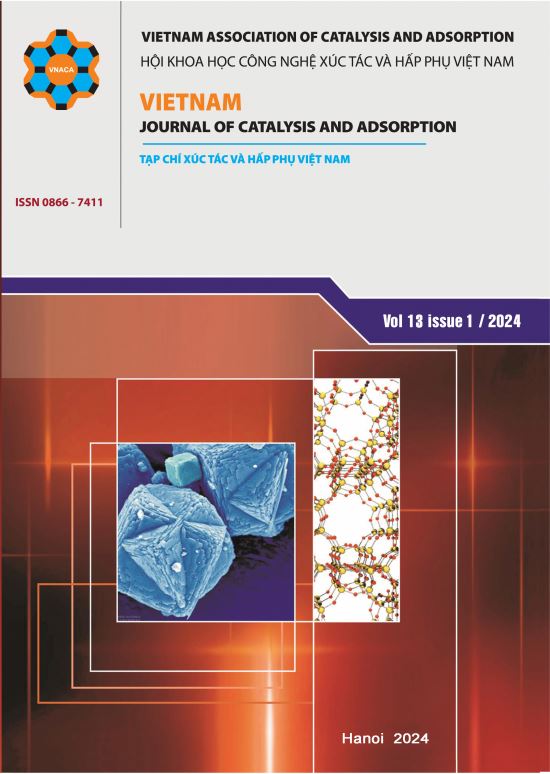Removal of ion Cu2+ and Pb2+ using zeolite NaP1 with the silica source utilized from rice husk ash
DOI:
https://doi.org/10.62239/jca.2024.008Keywords:
zeolite NaP1, rice husk ash, without aging, energy-saving, adsorptionAbstract
Zeolite, as chemical essence, is an aluminosilicate mineral synthesized by rich-silica source, such as rice husk ash (RHA). This study focuses on the synthesis of zeolite NaP1 under a facial hydrothermal method using the silica source utilized from RHA without any -pretreatment steps. The synthesis conditions of the synthesis are achieved at the molar ratio of 8 Na2O: 6 SiO2: 1 Al2O3, at 100oC, 8 hours, and without aging. Scanning electron microscope (SEM), dynamic light scattering (DLS), Brunauer-Emmett-Teller (BET), and X-ray diffraction (XRD) are used to determine the physical and chemical properties of the product. Adsorption results show that the optimal conditions are the initial concentration of 75 mg/L, adsorbent dose of 0.5 g/L, and contact time of 30 mins. Ion Cu2+ removal can reach a capacity and efficiency of 57.4 mg/g and 95.7%, respectively while Pb2+ adsorption can achieve a capacity and efficiency of 59.2 mg/g and 98.6%, respectively. Besides, Langmuir, Freundlich, Dubinin – Radushkevich (D-R), Temkin, Sips, and Redlich - Peterson models are also applied to describe the adsorption process.
Downloads
References
S. Khan, M. Idrees, M. Bilal, Colloids Surf. A Physicochem. Eng. Asp. 623 (2021) 126711. https://doi.org/10.1016/j.colsurfa.2021.126711
L.R. Rad, M. Anbia, Environ. Chem. Eng. 95 (2021) 106088. https://doi.org/10.1016/j.jece.2021.106088
S.S. Hossain, L. Mathur, P. Roy, J. Asian Ceram. Soc. 64 (2018) 299-313. https://doi.org/10.1080/21870764.2018.1539210
R. Mohamed, I. Mkhalid, M. Barakat, Arab. J. Chem. 81 (2015) 48-53. https://doi.org/10.1016/j.arabjc.2012.12.013
D.H.L. Thanh, D.T.T. Ha, TNU Journal of Science and Technology 226 (2021) 93-99. https://doi.org/10.34238/tnu-jst.4345
P.T.M. Huong, N.M. Ha, VietnamJournal of Catalysis and Adsorption 11 (2022) 92-97. https://doi.org/10.51316/jca.2022.076
D.Q. Huy, D.Q. Khanh, N.X. Truong, N.D. Hue, VNU Journal of Science: Natural Sciences and Technology 23 (2007) 160-165. https://js.vnu.edu.vn/NST/article/view/2186
N.X. Hai, N.N. Minh, L.V. Kireycheva, P.A. Hung, P.D. Pha, V.T.H. Ha, D.K. Van, VNU Journal of Science: Natural Sciences and Technology 27 (2011) 171-178. https://js.vnu.edu.vn/NST/article/view/1324
P. Sharma, J.S. Song, M.H. Han, C.H. Cho, Scientific Reports 61 (2016) 1-26. https://doi.org/10.1038/srep22734
P.L. Tran-Nguyen, K.P. Ly, L.H.V. Thanh, A.E. Angkawijaya, S.P. Santoso, N.P.D. Tran, M.L. Tsai, Y.H. Ju, J. Taiwan Inst. Chem. Eng. (2021) 1-8. https://doi.org/10.1016/j.jtice.2021.05.009
K.Y. Foo, B.H. Hameed, Chem. Eng. J. 1561 (2010) 2-10. https://doi.org/10.1016/j.cej.2009.09.013
P. Sharma, J.-g. Yeo, M.H. Han, C.H. Cho, J. Mater. Chem. 17 (2013) 2602-2612. https://doi.org/10.1039/C2TA01311H
I.O. Ali, S.M. El-Sheikh, T.M. Salama, M.F. Bakr,M.H. Fodial, Sci. China Mater 58 (2015) 621-633. https://doi.org/10.1007/s40843-015-0075-9
V.S. Raghuwanshi, U.M. Garusinghe, J. Ilavsky, W.J. Batchelor, G. Garnier, J. Colloid Interface Sci. 510 (2018) 190-198. https://doi.org/10.1016/j.jcis.2017.09.064
E. Erdem, N. Karapinar, R. Donat, J. Colloid Interface Sci. 2802 (2004) 309-314. https://doi.org/10.1016/j.jcis.2004.08.028
X. Pu, L. Yao, L. Yang, W. Jiang, X. Jiang, J. Clean. Prod. 265 (2020) 121822. https://doi.org/10.1016/j.jclepro.2020.121822
Y. Liu, G. Wang, L. Wang, X. Li, Q. Luo, P. Na, Chin. J. Chem. Eng. 272 (2019) 341-348. https://doi.org/10.1016/j.cjche.2018.03.032
X. Lu, D. Shi, J. Chen, Environ. Earth Sci. 76 (2017) 1-10. https://doi.org/10.1007/s12665-017-6923-z
A. Utami, S. Sugiarti, P. Sugita, J Rasayan J. Chem 122 (2019) 650-658. http://dx.doi.org/10.31788/RJC.2019.1222056
P.K. Pandey, S. Sharma, S. Sambi, J. Environ. Chem. Eng. 34 (2015) 2604-2610. https://doi.org/10.1016/j.jece.2015.09.008
T. Hussain, A.I. Hussain, S.A.S. Chatha, A. Ali, M. Rizwan, S. Ali, P. Ahamd, L. Wijaya, M.N. Alyemeni, Int. J. Environ. Res. Public Health 187 (2021) 3373. https://doi.org/10.3390/ijerph18073373
Downloads
Published
Issue
Section
How to Cite
Share
Funding data
-
National Foundation for Science and Technology Development
Grant numbers 103.02-2020.64










